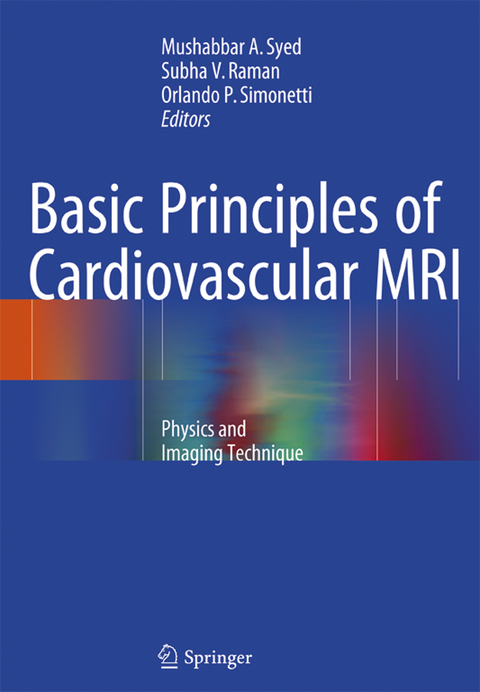
Basic Principles of Cardiovascular MRI
Springer International Publishing (Verlag)
978-3-319-37113-9 (ISBN)
Dr. Mushabbar Syed is an associate professor of medicine and radiology at Stritch School of Medicine, Loyola University of Chicago USA. He also serves as the director of cardiovascular imaging. Prior to his current position, Dr. Syed was an associate professor of medicine and radiology and director of cardiovascular CT & MRI imaging at University of Kentucky, Lexington, Kentucky and assistant professor of medicine and radiology at Emory University School of Medicine, Atlanta, Georgia. Dr. Syed completed his medicine and cardiology training at Henry Ford Hospital, Detroit, Michigan followed by a clinical/research fellowship in cardiovascular MRI at the National Heart, Lung & Blood Institute, National Institutes of Health, Bethesda, Maryland. He has recently co-edited a textbook titled “Magnetic Resonance Imaging in Congenital Heart Disease” published by Springer Inc. 2012. Subha Raman, MD, MSEE, FACC, is a cardiologist and associate professor of medicine at The Ohio State University Medical Center. After undergraduate and graduate studies in electrical engineering as a National Science Foundation Fellow, Dr. Raman completed medical training including fellowship in cardiovascular medicine at The Ohio State University College of Medicine, with additional training in cardiovascular magnetic resonance (CMR) at Wake Forest University. Dr. Raman has published more than 70 papers and was named one of America’s Best Doctors in 2009. Her clinical interests include family risk and heritable heart disease, women’s cardiovascular health, early atherosclerosis detection and management, and improved stress testing. Dr. Raman’s research team works to develop innovations in cardiovascular imaging that provide earlier detection, more accurate diagnosis and personalized treatment of heart and vascular disease.
MRI scanner and coils.- Signal generation.- k-space.- Pulse sequence.- Image acquisition.- Image resolution.- Fast imaging.- High field MRI (3 Tesla or higher) .- Artifacts.- MRI safety.- Gating.- Gradient echo and cine imaging.- Black blood imaging and tissue characterization.- Perfusion.- Stress testing.- Late gadolinium enhancement imaging (scar/fibrosis) .- Phase contrast flow.- Coronary imaging.- Spectroscopy.- Contrast media.- Contrast enhanced MRA.- Non-contrast enhanced MRA.- Advanced cardiovascular magnetic resonance techniques.
"The text is aimed at fellowship trainees but also as an aide-memoire for the established practitioner. It would be of great assistance to cardiovascular radiographers, explaining clearly many of the artefacts associated with this complex imaging technique and providing practical solutions. ... In a world where the time to understand and develop new techniques and services becomes fewer, as the pressure to deliver scans or scan reports increases, this book is an essential addition to an individual's or department's library." (Dr. Roger Bury, RAD Magazine, December, 2016)
| Erscheint lt. Verlag | 21.2.2018 |
|---|---|
| Zusatzinfo | XIV, 338 p. 239 illus., 142 illus. in color. |
| Verlagsort | Cham |
| Sprache | englisch |
| Maße | 210 x 279 mm |
| Gewicht | 1233 g |
| Themenwelt | Medizinische Fachgebiete ► Innere Medizin ► Kardiologie / Angiologie |
| Medizinische Fachgebiete ► Radiologie / Bildgebende Verfahren ► Radiologie | |
| Schlagworte | Contrast enhanced MRA • diagnostic radiology • gadolinium enhancement • image acquisition • Magnetic Resonance Imaging • Perfusion • Stress Testing |
| ISBN-10 | 3-319-37113-4 / 3319371134 |
| ISBN-13 | 978-3-319-37113-9 / 9783319371139 |
| Zustand | Neuware |
| Haben Sie eine Frage zum Produkt? |
aus dem Bereich


